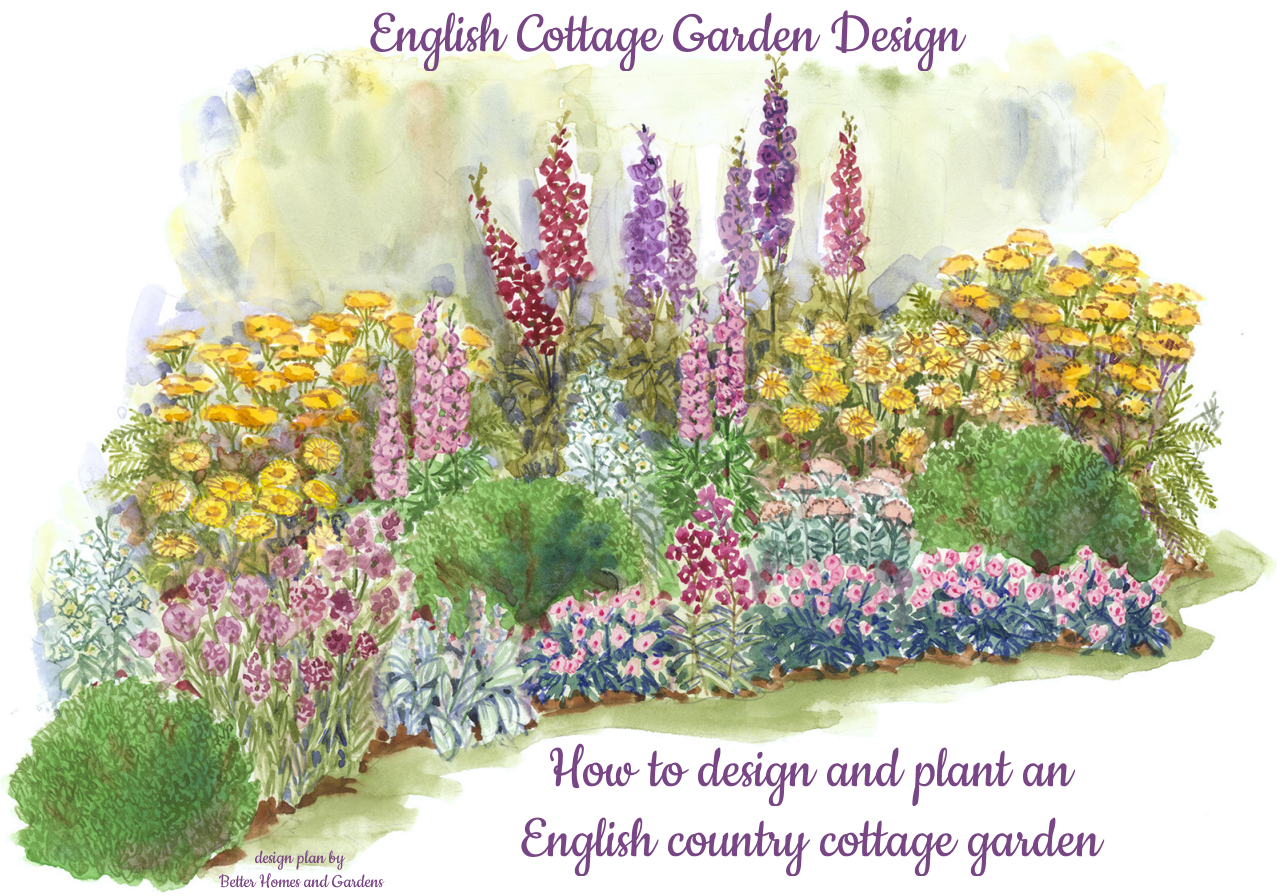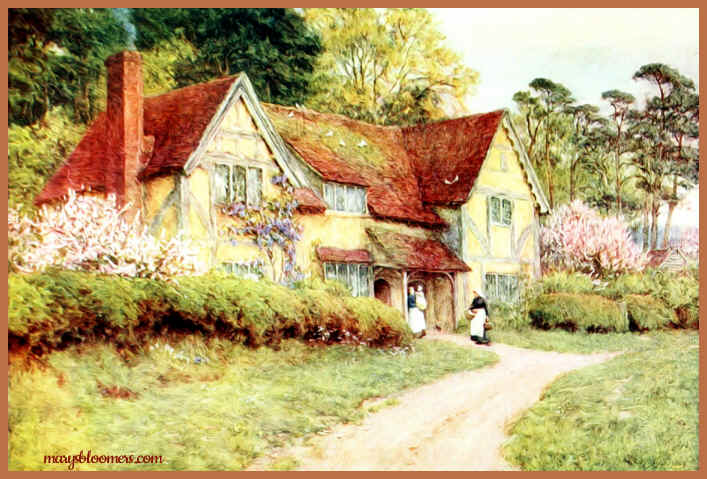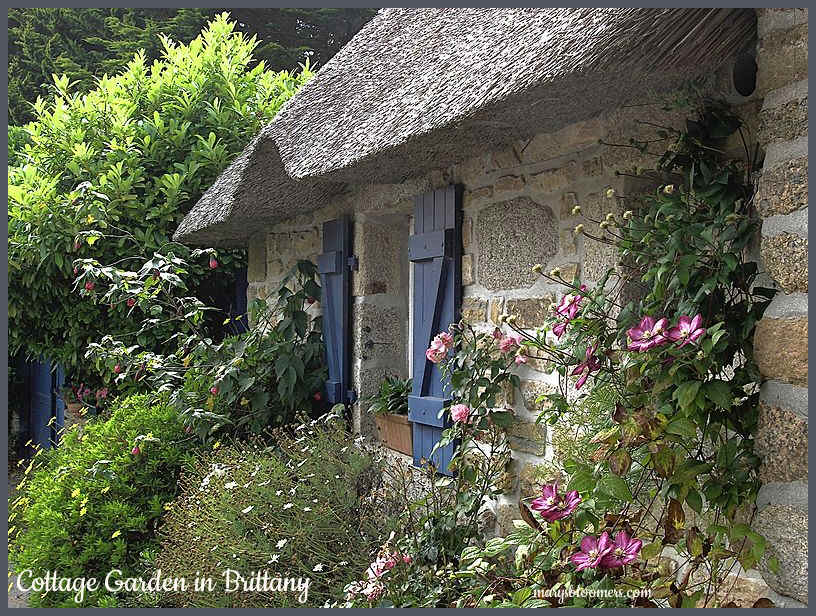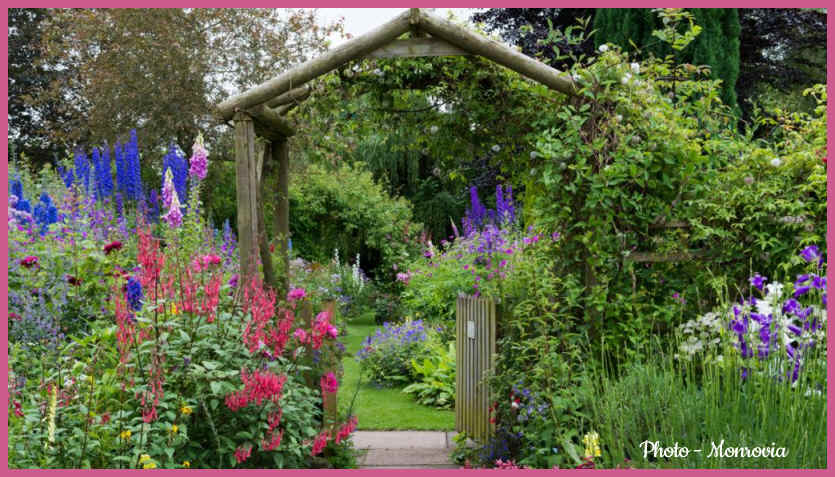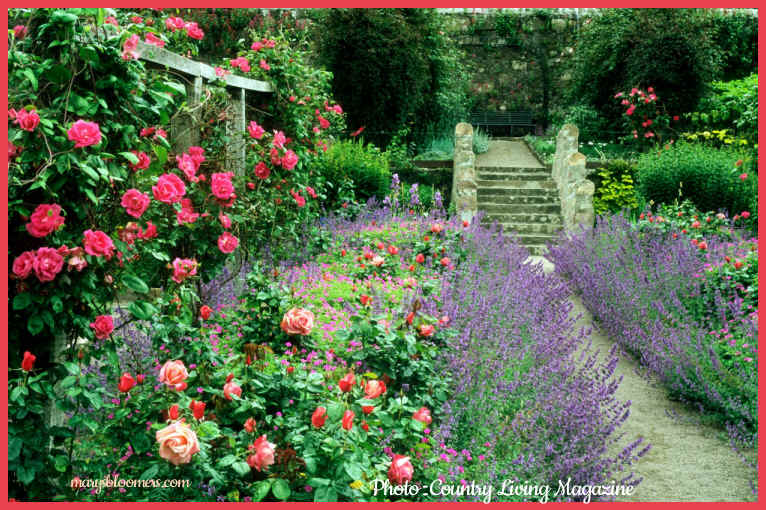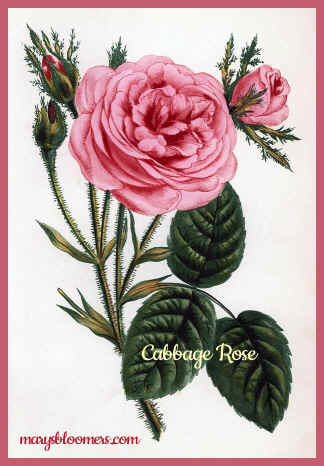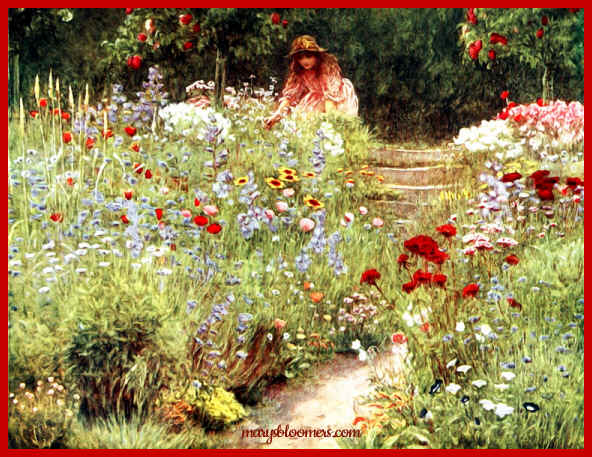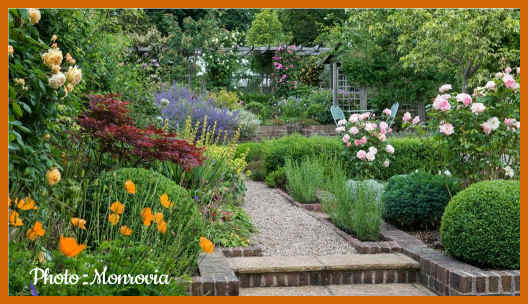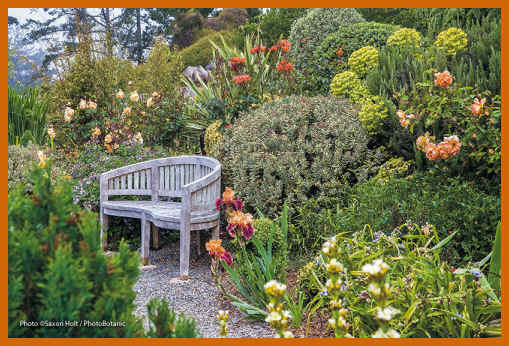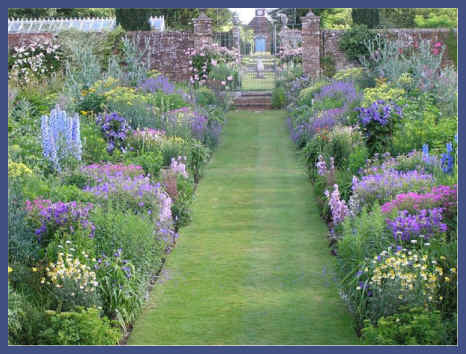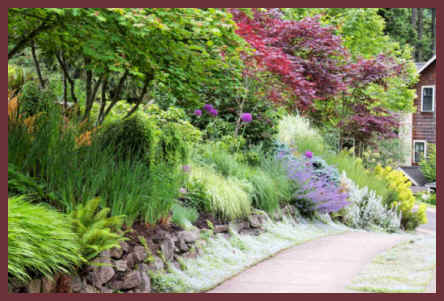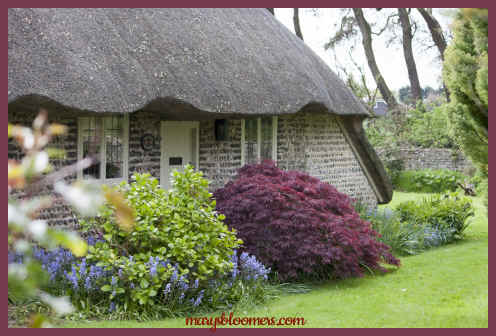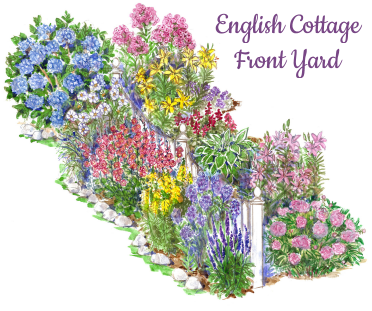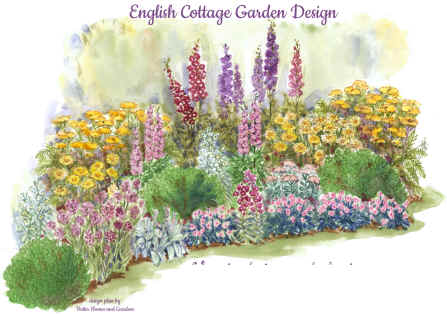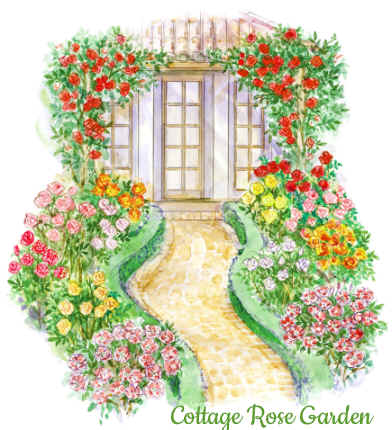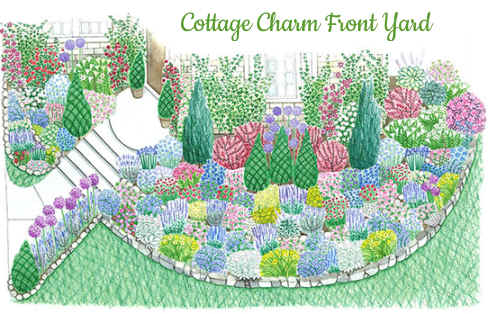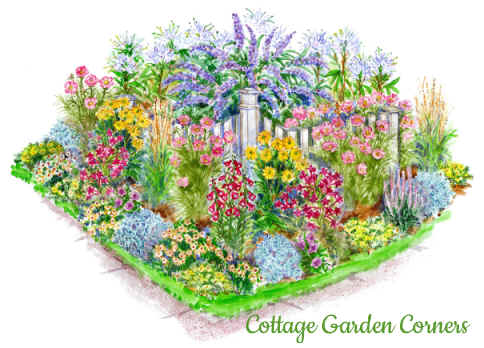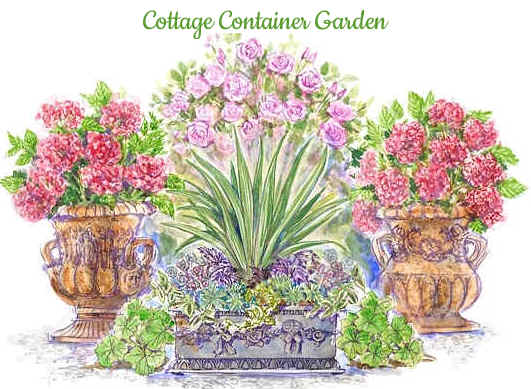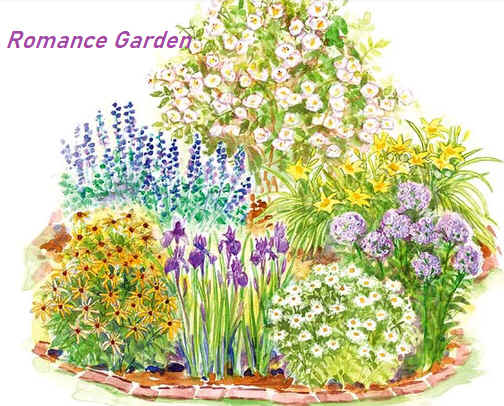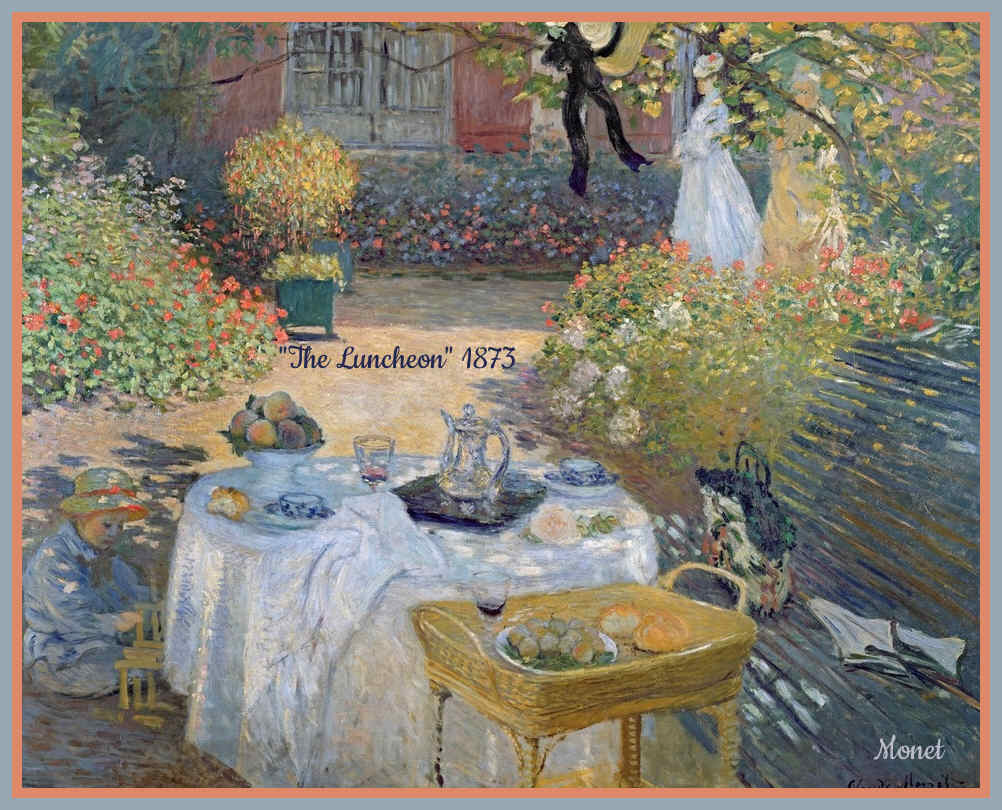|
|
| The cottage garden
is a distinct style that uses informal design, traditional materials,
dense plantings, and a mixture of ornamental and edible plants. English
in origin, it depends on grace and charm rather than grandeur and formal
structure. Homely and functional gardens connected to cottages go back
centuries, but their stylized reinvention occurred in 1870s England, as
a reaction to the more structured, rigorously-maintained English
estate gardens with their formal designs and mass plantings
of greenhouse annuals.
Cottage gardens are natural pollinator friendly gardens, attracting bees, butterflies and birds with the wide variety of pollen and nectar-producing flowers. Download Free Cottage Garden Design Plans in .pdf format--> The earliest cottage gardens were more practical than today's Emphasis was not on ornamentals, but was much more on vegetables and herbs, fruit trees, perhaps a beehive, and even livestock. Flowers, used to fill spaces, gradually became more dominant. The traditional cottage garden was usually enclosed, sometimes with a rose arbor gateway. Flowers common to early cottage gardens included traditional florists' flowers like primroses and violets, along with flowers with household use such as calendula and various herbs. Others were the richly scented old-fashioned roses that bloomed once a year, and simple flowers like daisies. In time, cottage-garden sections were added to some large estate gardens. Until the late 19th century, cottage gardens mainly grew vegetables for household consumption. Typically half the garden would be used for cultivating potatoes and half for a mix of other vegetables plus some culinary and medicinal herbs. John Claudius Loudon wrote extensively on cottage gardens in his book An Encyclopædia of Gardening (1822) and in Gardener's Magazine from 1826. In 1838 he wrote "I seldom observe any thing in a cottage garden but potatoes, cabbages, beans, and French beans; in a few instances onions and parsnips, and very seldom a few peas". An 1865 issue of The Farmer's Magazine noted that in "Ireland and much of the Highlands of Scotland, potatoes are the only thing grown in the cottage-garden".
Modern cottage garden plants are typically flowers chosen for their old-fashioned and informal appeal. Many modern day gardeners use heirloom or 'old-fashioned' plants and varieties—even though these may not have been authentic or traditional cottage garden plants. In addition, there are modern varieties of flowers that fit into the cottage garden look. Modern cottage gardens often use native plants, and those adapted to the local climate, rather than trying to force traditional English plants to grow in an incompatible environment—though many of the old favorites thrive in cottage gardens throughout the world. Cottage gardens include countless regional and personal variations and embrace plant materials, such as ornamental grasses or native plants not seen in the rural gardens of cottagers. Traditional roses, with their full fragrance and lush foliage, continue to be a cottage garden mainstay—along with modern disease-resistant varieties that retain traditional attributes. Informal climbing plants, whether traditional or modern hybrids, are also common, as are the self-sowing annuals and freely spreading perennials favored in traditional cottagers' gardens. To learn about cottage garden plants and design for your own gardens, visit this page.
Cottage Garden History Cottage gardens, which emerged in Elizabethan times, appear to have originated as a local source for herbs and fruits. One theory is that they arose out of the Black Death of the 1340s, when the death of so many laborers made land available for small cottages with personal gardens. According to the late 19th-century legend of origin, these gardens were originally created by the workers that lived in the cottages of the villages, to provide them with food and herbs, with flowers planted in for decoration. Authentic gardens of the cottager would have included a beehive and livestock, and frequently a pig and a sty, along with a well. The peasant cottager of medieval times was more interested in meat than flowers, with herbs grown for medicinal use and cooking, rather than for their beauty. By Elizabethan times there was more prosperity, and more room to grow flowers. Even the early cottage garden flowers typically had their practical use—violets were spread on the floor (for their pleasant scent and keeping out vermin); calendulas and primroses were both attractive and used in cooking. Others, such as sweet william and hollyhocks, were grown entirely for their beauty. In the early 20th century the term "cottage garden" might be applied even to as large and sophisticated a garden as Hidcote Manor, in England. The cottage garden ideal was also spread by artists such as water-colorist Helen Allingham (1848–1926). Another influence was Margery Fish (1892–1969), whose garden survives at East Lambrook Manor.
Design While the classic cottage garden is built around a cottage, many cottage-style gardens are created around houses and even estates. The cottage garden design is based more on principles than formula: it has an informal look, with a seemingly casual mixture of flowers, herbs, and vegetables often packed into a small area. In spite of their appearances, cottage gardens have a design and formality that help give them their grace and charm. Due to space limitations, they are often in small rectangular plots, with practical functioning paths and hedges or fences. The plants, layout, and materials are chosen to give the impression of casualness and a country feel. Modern cottage gardens frequently use local flowers and materials, rather than those of the traditional cottage garden. What they share with the tradition is the unstudied look, and the use of every square inch, and a wide variety of flowers, herbs, and vegetables. The cottage garden is designed to appear as though nature grew it without a plan, rather than being contrived or pretentious. Instead of artistic curves, or grand geometry, there is an artfully designed irregularity. Borders can go right up to the house, lawns are replaced with tufts of grass or flowers, and beds can be as wide as needed. Instead of the discipline of large scale color schemes, there is the simplicity of harmonious color combinations between neighboring plants. The overall appearance can be of "a vegetable garden that has been taken over by flowers." The method of planting closely-packed plants was supposed to reduce the amount of weeding and watering required. Paths, arbors, and fences use traditional or antique-looking materials. Wooden fences and gates, paths covered with locally made bricks or stone, and arbors using natural materials all give a more casual—and less formal—look and feel to a cottage garden. Pots, ornaments, and furniture also use natural-looking materials with traditional finishes—everything is chosen to give the impression of an old-fashioned country garden.
The Flowers Cottage gardens have always been grown with particularly flamboyant and fragrant flowers. The most popular are hollyhock, delphinium, foxglove, larkspur, lots of climbing and shrub roses, peonies and lavender. These gardens are naturally pollinator-friendly. Many of the tall and bold flowers were stunning in vases. Big and Beautiful Fragrant Roses Cottage gardens have always associated with roses: shrub roses, climbing roses, and old-fashioned cottage roses with lush foliage, and not even close to the close to the gangly modern hybrid tea roses. Old cottage garden roses include cultivated forms of Rosa gallica, which form dense mounded shrubs 3–4 ft high and wide, with pale pink to purple flowers—with single and full double blooms. They are also very fragrant, and include the ancient Apothecary's rose (R. gallica 'Officinalis'), whose magenta flowers were preserved solely for their fragrance. Another old fragrant cottage garden rose is the Damask rose, which is still grown in Europe for use in perfumes. Cultivated forms of this grow 4 to 6 ft or higher, with gently arching canes that help give an informal look to a garden. Even taller are the Alba roses that bloom well, even in partial shade. The Provence rose or Rosa centifolia is the full and fat "cabbage rose" made famous by Dutch masters in their 17th-century paintings. These very fragrant shrub roses grow 5 ft tall and wide, with a floppy habit that is aided by training on an arch or pillar. The centifolia roses have produced many descendants that are also cottage garden favorites, including varieties of moss rose (roses with attractive 'mossy' growth on their flower stalks and flower buds). Unlike most modern hybrids, the older roses bloom on the previous year's wood, so they aren't pruned back severely each year. Also, since they don't bloom continuously, they can share their branches with later-flowering climbers such as Clematis vines, which use the rose branches for support. A rose in the cottage garden is not segregated with other roses, with bare earth or mulch underneath, but is casually blended with other flowers, vines, and groundcover.
With the introduction of China roses (derived from Rosa chinensis) late in the 18th century, many hybrids were introduced that had the repeat-blooming nature of the China roses, but maintained the informal old rose shape and flower. These included the Bourbon rose and the Noisette rose. Climbing plantsMany of the old roses had cultivars that grew very long canes, which could be tied to trellises or against walls. These older varieties are called "ramblers", rather than "climbers". Climbing plants in the traditional cottage garden included European honeysuckle (Lonicera periclymenum) and Traveller's Joy (Clematis vitalba). The modern cottage garden includes many Clematis hybrids that have the old appeal, with sparse foliage that allows them to grow through roses and trees, and along fences and arbors. There are also many Clematis species used in the modern cottage garden. Hedging plants
In the traditional cottage garden,
hedges served as fences on the perimeter to keep out marauding livestock
and for privacy, along with other practical uses. Hawthorn leaves made a
tasty snack or tea, while the flowers were used for making wine. The
fast-growing Elderberry, in addition to creating a hedge, provided
berries for food and wine, with the flowers being fried in batter or
made into lotions and ointments. The wood had many uses, including toys,
pegs, skewers, and fishing poles. Holly was another hedge plant, useful
because it quickly spread and self-seeded. Privet was also a convenient
and fast-growing hedge. Over time, more ornamental
plants became popular cottage garden hedges, including laurel, lilac,
snowberry, japonica, and others.
And Herbs... Popular flowers in the traditional cottage garden included florist's flowers which were grown by enthusiasts—such as violets, pinks, and primroses and those grown with a more practical purpose. The calendula, grown today almost entirely for its bright orange flowers, was primarily valued for eating, for adding color to butter and cheese, for adding smoothness to soups and stews, and for all kinds of healing salves and preparations. Like many old cottage garden annuals and herbs, it freely self-sowed, making it easier to grow and share. Other popular cottage garden annuals included violets, pansies, stocks, and mignonette. Perennials were the largest group of traditional cottage garden flowers—those with a long cottage garden history include hollyhocks, carnations, sweet williams, marguerites, marigolds, lilies, peonies, tulips, crocus, foxglove, monkshood, lavender, campanulas, Solomon's seal, evening primrose, lily-of-the-valley, primrose, cowslips. More low maintenance flower ideas: , Bee Balm (Monarda)columbine, bellflowers, coral bells, daisies, delphinium, dianthus, Irises, Lady's Mantle and violets. Today herbs are typically thought of as culinary plants, but in the traditional cottage garden they were considered to be any plant with household uses. Herbs were used for medicine, toiletries, and cleaning products. Scented herbs would be spread on the floor along with rushes to cover odors. Some herbs were used for dyeing fabrics. Traditional cottage garden herbs included sage, thyme, southernwood, wormwood, catmint, feverfew, lungwort, soapwort, hyssop, sweet woodruff, and lavender. Fruits, Shrubs, and TreesThe most popular shrubs were roses and big leaf hydrangeas. Fruit in the traditional cottage garden would have included an apple and a pear, gooseberries and raspberries. The modern cottage garden includes many varieties of ornamental fruit and nut trees, such as crabapple and hazel, along with non-traditional trees like dogwood.
Lovely English Cottage Garden Designs
Free
Cottage Garden Design Plans .pdfs.
Compiled from these Sources: Wikipedia
Quick Links Content, graphics,
photos and design ©2020 marysbloomers.com |
